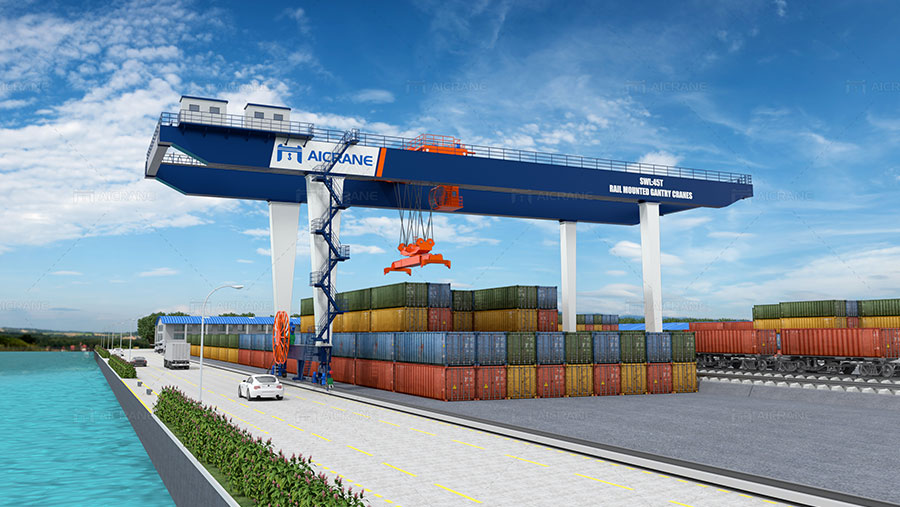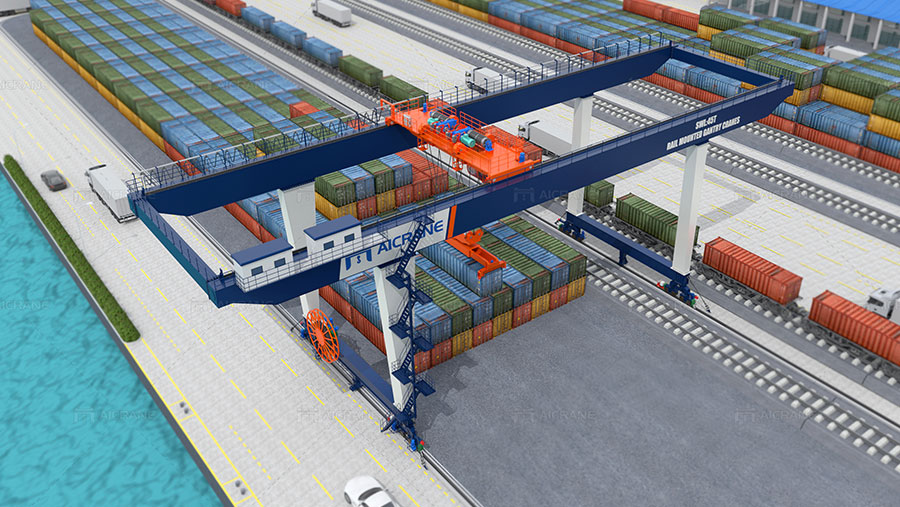Container gantry cranes are essential components of modern ports and coastal facilities, where they play a critical role in the efficient handling and transfer of containerized cargo. These cranes are designed to lift heavy containers from ships to shore or vice versa, facilitating the seamless flow of goods across the globe. Given the challenging conditions found in coastal and port environments, these cranes must be specially adapted to ensure both performance and longevity. This article will explore the key structural adaptations made to container gantry cranes to withstand the harsh conditions typically found in coastal and port settings, including corrosion resistance, structural reinforcement, and environmental considerations.

1. Corrosion Resistance in Coastal Environments
The most significant environmental challenge faced by container gantry crane in coastal or port environments is the constant exposure to saltwater and high humidity. These conditions accelerate the process of corrosion, which can severely impact the crane’s structural integrity, safety, and operational performance. To combat this, the crane’s design must include specialized materials and protective coatings to prevent rust and corrosion.
Material Selection: One of the first structural adaptations is the selection of materials that offer better resistance to corrosion. Steel, being the primary material for crane construction, is often treated with special alloys or coatings to improve its resilience. Stainless steel, for example, is commonly used for critical components, such as the crane’s frames, jib, and other structural elements exposed to saltwater. For less critical areas, a coating of galvanized steel or weather-resistant alloys such as corten steel can be applied. These materials not only enhance the crane’s corrosion resistance but also ensure that the equipment remains robust despite the challenging coastal environment.
Protective Coatings: In addition to using corrosion-resistant materials, container gantry cranes are often coated with anti-corrosion paints or zinc-based coatings. These coatings act as a protective barrier against saltwater and moisture, reducing the likelihood of rust and decay. For example, epoxy coatings and polyurethane paints are commonly applied to the crane’s steel frame and moving parts to extend their service life. In some cases, additional layers of protective coatings may be used for areas that are exposed to the most extreme conditions, such as near the base of the crane’s legs or the areas near the dock.

2. Reinforced Structural Framework
Container gantry cranes must be designed to support heavy loads, often weighing several tons, while also withstanding the impact of wind forces, seismic activity, and other environmental factors common in coastal areas. The structural framework of these port gantry cranes must be reinforced to ensure that they maintain operational stability and safety in these conditions.
Wind Resistance: Coastal and port environments are often subject to strong winds, particularly in areas that are prone to storms or hurricanes. To protect the crane’s structural integrity, the design must account for high wind loads. This is achieved by reinforcing key structural elements such as the crane’s boom and tower. The addition of wind bracing systems helps distribute wind loads more evenly across the crane structure. Additionally, the use of larger, heavier foundations and more robust anchoring systems ensures that the crane remains anchored in place, even in the face of extreme weather conditions.
Seismic Considerations: In certain coastal regions, earthquakes or seismic activity can also be a concern. To address this, container gantry cranes may be equipped with seismic-resistant features. These features can include reinforced foundations, flexible joints, and shock-absorbing components to help the crane withstand ground movement without sustaining damage. The design and construction of cranes in earthquake-prone regions also involve advanced engineering analysis to ensure that all load-bearing components are able to absorb and distribute seismic forces effectively.
3. Durability and Wear Resistance of Moving Parts
The operational efficiency of a container gantry crane is largely dependent on the performance of its moving parts, such as the trolley, hoist, and track systems. These components are subjected to constant movement, heavy loads, and the corrosive effects of saltwater. To maintain their durability and ensure smooth operations, specific adaptations are made to reduce wear and tear in coastal environments.
Bearings and Rails: The gantry crane’s rails and bearings are critical components that enable the smooth movement of the crane along its tracks. In coastal environments, special attention is given to the selection of high-quality, corrosion-resistant materials for these parts. Stainless steel or specially coated rail systems help prevent rusting and reduce friction, which can extend the life of the RMG crane and improve efficiency. Additionally, the crane’s bearings are often sealed and lubricated with advanced oils and greases that are resistant to water and salt, further preventing corrosion and ensuring long-term reliability.
Lubrication Systems: A critical part of crane maintenance in coastal environments is the lubrication of moving components. Coastal exposure can cause lubricants to break down more quickly, leading to increased friction and wear. To mitigate this, container gantry cranes often use advanced, marine-grade lubricants that are resistant to saltwater and capable of withstanding extreme temperatures. These lubricants are designed to reduce friction between moving parts and prevent the formation of rust, which can otherwise compromise the crane’s operation.
4. Enhanced Foundation and Stability
The stability of a container gantry crane is heavily influenced by the foundation upon which it sits. Coastal areas, particularly those with soft soils, loose ground, or fluctuating water levels, require specially designed foundations to ensure that the crane remains stable during operations.
Foundation Reinforcement: In coastal regions, cranes often have to operate on soil that is unstable or subject to shifting. To address this, container gantry cranes are often installed with reinforced foundations, including deeper footings, piles, or concrete platforms, which help distribute the weight of the crane more evenly. In some cases, additional stabilizers, such as submerged anchors, are used to further secure the crane and reduce the risk of tipping during high winds or heavy loads.
Flood Protection: Coastal areas are vulnerable to flooding, especially during high tides or extreme weather events like hurricanes. In response to this, some container gantry cranes are equipped with flood protection systems. These may include elevated foundations that raise the crane above potential flood levels, as well as water-tight enclosures around critical components to prevent water from damaging sensitive machinery. By adapting the crane’s structure to handle flooding risks, operators can ensure that the crane remains operational even in adverse conditions.
5. Monitoring and Maintenance Systems
In coastal environments, where wear and tear due to saltwater and high humidity can quickly degrade a crane’s performance, implementing a proactive monitoring and maintenance system becomes crucial for keeping cranes operational.
Monitoring Systems: Modern container gantry crane for sale comes equipped with real-time monitoring systems that track the health and performance of critical components, including the lifting mechanism, motors, bearings, and structural integrity. These systems can detect early signs of wear, corrosion, or structural fatigue, allowing for timely maintenance and preventing costly breakdowns. In coastal environments, where the conditions are particularly harsh, these systems are invaluable for ensuring that the crane operates at peak efficiency and safety.
Regular Maintenance: The harsh coastal environment necessitates frequent maintenance of container gantry cranes. Operators must routinely inspect and replace parts that are vulnerable to corrosion or wear. This includes checking the crane’s coating and repainting surfaces as needed, cleaning and re-lubricating moving parts, and ensuring that all seals and protective barriers are intact. By maintaining a consistent maintenance schedule, operators can extend the lifespan of their cranes and minimize downtime caused by environmental factors.
Conclusion
Container gantry cranes are vital for the efficient operation of ports and coastal facilities. In these challenging environments, specialized structural adaptations are necessary to ensure that these cranes can handle the demands of heavy-duty lifting while withstanding the corrosive effects of saltwater, strong winds, and shifting foundations. By incorporating corrosion-resistant materials, reinforcing structural frameworks, ensuring the durability of moving parts, and implementing flood protection and advanced monitoring systems, container gantry cranes can be adapted to thrive in coastal and port environments. Through thoughtful design and proactive maintenance, these cranes continue to be essential tools in global trade, ensuring the smooth flow of goods across the seas.